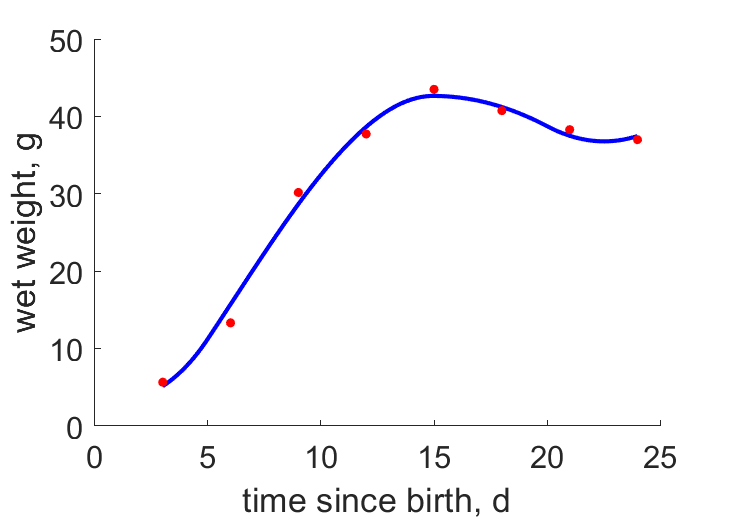Predictions & Data for this entry
| Model: std | climate: A, BSh, Cwa, Cwb, Dwa | migrate: Ms | phylum: |
| COMPLETE = 2.5 | ecozone: TPi | food: biCi | class: |
| MRE = 0.018 | habitat: 0iTi | gender: Dg | order: |
| SMSE = 0.001 | embryo: Tnwfm | reprod: O | family: |
Zero-variate data
| Data | Observed | Predicted | (RE) | Unit | Description | Reference |
|---|---|---|---|---|---|---|
| ab | 14.5 | 14.75 | (0.01745) | d | age at birth | Wiki |
| tx | 18 | 17.97 | (0.001748) | d | time since birth at fledging | Wiki |
| tp | 54 | 52.92 | (0.02007) | d | time since birth at puberty | guess |
| tR | 365 | 365 | ( 0) | d | time since birth at 1st brood | guess |
| am | 3650 | 3643 | (0.001849) | d | life span | guess |
| Ww0 | 4.8 | 4.427 | (0.07761) | g | initial wet weight | avibase |
| Wwi | 46 | 46.47 | (0.01021) | g | ultimate wet weight for females | avibase |
| Wwim | 51 | 51.08 | (0.001653) | g | ultimate wet weight for males | avibase |
| Ri | 0.009178 | 0.009112 | (0.007169) | #/d | maximum reprod rate | avibase |
Uni- and bivariate data
| Data | Figure | Independent variable | Dependent variable | (RE) | Reference |
|---|---|---|---|---|---|
| tW |  | time since birth | wet weight | (0.03211) | NithAsok2015 |
Pseudo-data at Tref = 20°C
| Data | Generalised animal | Dicrurus macrocercus | Unit | Description |
|---|---|---|---|---|
| v | 0.02 | 0.03902 | cm/d | energy conductance |
| p_M | 18 | 572.8 | J/d.cm^3 | vol-spec som maint |
| k_J | 0.002 | 0.02358 | 1/d | maturity maint rate coefficient |
| k | 0.3 | 0.3018 | - | maintenance ratio |
| kap | 0.8 | 0.9661 | - | allocation fraction to soma |
| kap_G | 0.8 | 0.7989 | - | growth efficiency |
| kap_R | 0.95 | 0.95 | - | reproduction efficiency |
Discussion
- scaled functional response turned out to vary, which has been implemented
- Males are supposed to differ from females by {p_Am} only
- mod_1: Pseudo-data point k is used, rather than k_J; Data set tp and parameter t_R are added, the latter replacing clutch interval t_N. Postnatal T is based on PrinPres1991, see get_T_Aves. See further the revision page, theme puberty
Bibliography